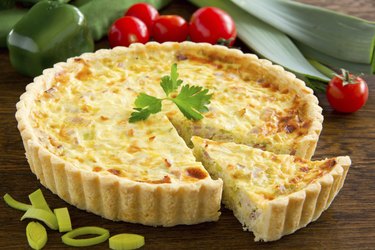
Quiche – the any-time-of-day, versatile egg dish that's usually baked with a buttery, flaky crust – is just as great, if not better, a day or two later. Quiches baked with attention to ingredients will still taste amazing cold. Just plan ahead, and follow a few storage tips for quality and safety.
Choose Your Ingredients Wisely
Video of the Day
If you're going to enjoy your quiche cold or as leftovers, pay particular attention to ingredients.
Video of the Day
Choose a cheese that you'd enjoy eating cold, like a sharp cheddar, shredded mozzarella or havarti.
Avoid vegetables that might make the quiche soggy over time, like juicy tomatoes. Think about texture – thin-sliced red potato or bell peppers are sturdy and won't suffer in the refrigerator.
Cold foods also require more flavoring because our noses and mouths don't smell aromas and experience tastes as strongly as they do with hot foods. Add extra spices, like cayenne for spice or nutmeg for warmth. Fresh herbs like chopped dill or chiffonade basil will really provide an aromatic punch.
Store It Properly
As soon as you pull the quiche out of the oven, cool it thoroughly and rapidly.
Follow the safe one-stage method of cooling to prevent bacterial growth. You'll bring the quiche down to at least 41 degrees Fahrenheit within 4 hours by:
- placing the quiche in a quick-cooling appliance, like a blast chiller;
- lifting the quiche from its pan and setting atop a wire rack for good air flow;
- immediately slicing, separating and individually cooling single portions;
- or setting the pan atop your stove below an active exhaust fan.
Don't cover the quiche with plastic wrap or aluminum foil before it has cooled; steam will not be able to escape and condensation will form, leaving a soggier quiche later (and a moist environment for bacteria).